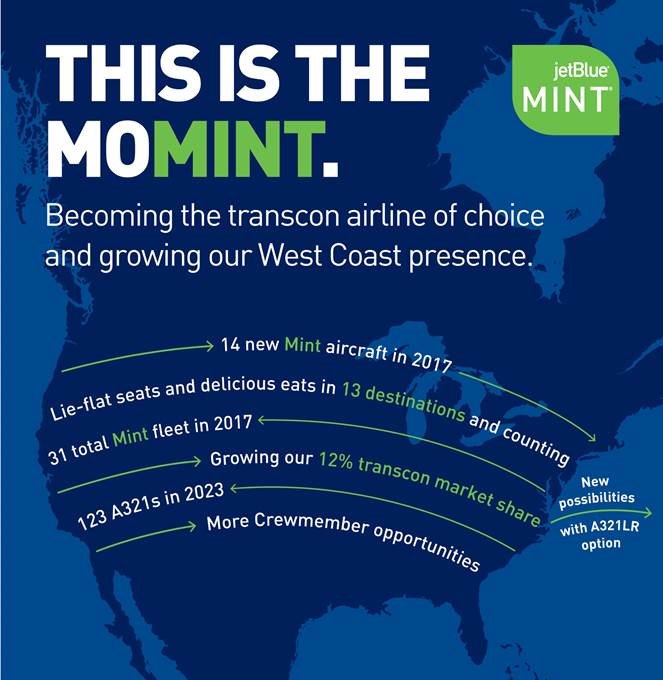A longer-range A321 could disrupt a crowded North Atlantic aviation market by potentially lowering some leisure travel fares.
When executives at JetBlue Airways Corp. gaze east to Europe from their perch in New York, they see a striking similarity to transcontinental domestic routes: abundant business traffic, high fares, entrenched rivals, and in-flight service quality that spans the spectrum.
Europe has one crucial difference, though. Fares are even higher and the revenue potential for premium travel even greater. And there is a weakness that a new Airbus jet may help the carrier exploit.
JetBlue is positioning itself to grab some market share in a European expansion that could start by 2019. The airline said on Tuesday it has taken options to convert 15 Airbus A321neo (new engine option) aircraft to the manufacturer’s newest variant in its A320 family, the A321LR, a single-aisle plane with pond-crossing capacity. Fitted with the kind of Mint premium cabin JetBlue launched two years ago from New York to Los Angeles and San Francisco, the new A321 would offer an opportunity for lucrative growth and transatlantic disruption, a word company executives used repeatedly to describe the opportunity.
JetBlue executives stressed that their options for the A321LR were merely contractual obligations required of its order book, and said that no decision will occur before the end of next year. Nonetheless, new JetBlue flights to Europe could jostle the transatlantic status quo.
“When you look at why Mint was successful, it was a very high fare, premium high-fare environment. And when you look at the opportunity across the Atlantic, it suffers from the same thing—extremely high premium fares,” JetBlue Chief Executive Officer Robin Hayes, a former British Airways Plc executive, told analysts. Right now, the highest-revenue market from Boston is travel to San Francisco, with London as No. 2, Marty St. George, JetBlue’s executive vice president for planning, said in an interview.
Doing battle with the alliances
JetBlue says 87 percent of the airline capacity across the Atlantic is covered by antitrust immunity regulators gave joint ventures established by the three major network alliances. That means that the Big Three U.S. carriers—American Airlines Group Inc., Delta Air Lines Inc., and United Continental Holdings Inc.—can legally collude with their European partners on schedules and pricing, helping boost financial returns. Almost two dozen airline alliances have been protected since 1993, when the Department of Transportation first blessed a Northwest Airlines-KLM joint venture.
JetBlue’s option to head east for future growth is “a pretty smart move,” given declining fares in Latin America, said George Ferguson, an aviation analyst with Bloomberg Intelligence. It will likely affect Northern European leisure routes the most, and JetBlue would probably take share from other leisure players such as Aer Lingus Group PLC, Air Canada, Norwegian, SAS AB, and WestJet Airlines Ltd., Ferguson wrote in an e-mail. “The full service carriers may have to cut some of their capacity to maintain fares, as it is likely they won't carry as much leisure travelers with more low-cost airlines in the fray,” Ferguson said.

The carrier’s lie-flat beds and gourmet foods on transatlantic routes could also attract more corporate traffic to JetBlue and create some new demand, as the carrier found when it began luring new customers with Mint, St. George said.
The JetBlue news comes less than two weeks after another low-cost player in the U.S.-Europe market, Norwegian Air Shuttle ASA, announced it had converted its order for 30 Airbus A320neos to 30 A321LRs. TAP Air Portugal and Air Lease Corp. have also ordered the LR version, which is expected to hit the market in 2019.
Exploiting a gap in seats
The airplane is Airbus’s attempt to wrest control of the longer-haul, single-aisle jet market from the 757, an aircraft Boeing Co. abandoned 12 years ago. Today, some of the hottest buzz in the aviation industry concerns whether Boeing will launch a new “Mom” (middle of market) airplane to replace the 757—a model numerous airlines still favor because of its unique performance capabilities.
All three U.S. network carriers fly the 757-200 on thinner European routes for which a larger plane has too many seats. Boeing’s largest 737 is too small for some customers, while the smallest 787 is too large, leaving what some have called a gap in the 220-seat middle of Boeing’s product lineup. It’s this segment that Airbus has worked to exploit with the A321, particularly when it extended the range and began touting the LR version last year as a 757 replacement. The A321LR will burn 30 percent less fuel than 757s, John Leahy, Airbus’s top salesman, has said.
Still, with a range of about 4,000 nautical miles, roughly the same as a 757, the A321LR will face an issue that bedevils the 757 flying westbound on certain winter days, when headwinds are fierce, Ferguson said. U.S. airlines have been forced to divert periodically to refuel.
But weighed against the money travelers now spend to cross the North Atlantic, an occasional refueling stop is a modest cost JetBlue might not mind.

No comments:
Post a Comment